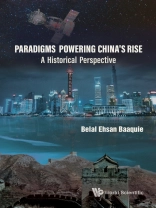The primary aim of this book is to understand the ground-breaking paradigms and policies that have powered China’s remarkable rise: from an agricultural society to an industrial powerhouse and a leading nation — and that too in a span of merely forty years from 1979 to 2019. The book covers the rise of China up to 2019 and is divided into five parts. The first part takes a strategic view of China’s rise, the second part provides a quantitative assessment of China’s rise using macroeconomic indicators; the third part provides a historical background of modern China, starting from the unification of China in 221 BC to the rise to power of the Communist Party of China, leading to the establishment of the People’s Republic of China in 1949. The fourth part analyses China’s governance as well as its economic system and lastly, part five summarizes China’s rise and the paradigms that powered this rise.
Contents:
- Preface
- About the Author
- Acknowledgments
- Foreground:
- Synopsis
- Strategic Perspective
- Assessing China’s Rise:
- China’s Macroeconomy
- China’s Peaceful Rise
- Summary of Part II
- Historical Background to China’s Rise:
- Chinese Dynasties: Unification and Fragmentation
- Rise of the Communist Party of China
- Summary of Part III
- China’s State and Economy:
- People’s Republic of China
- China’s Economic Paradigm
- Common Prosperity and Balanced Economic Growth
- Summary of Part IV
- Paradigms and China’s Rise:
- China’s Rise
- Epilogue
Readership: For academics, students and the general public who are interested to understand modern China and international developments.
Key Features:
- The author provides an unbiased assessment of China’s rise as a global power
- The book provides a historical as well as an empirical analysis of China’s rise
- The key features of China’s governance and economy are reviewed












